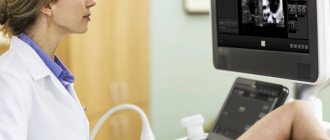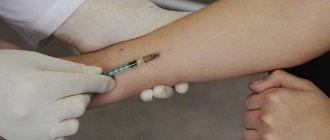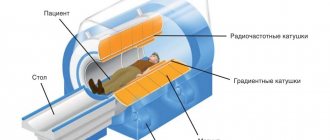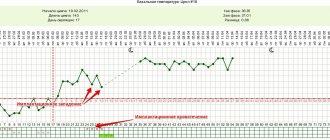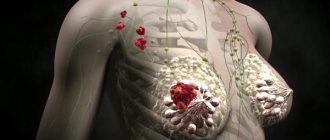With the help of a modern triple pregnancy screening program, identifying Down syndrome in a fetus using ultrasound is not difficult. At what time are these signs already visualized in the unborn baby? A comprehensive program with high accuracy (up to 91%) identifies such pathologies already at the first and second screening ultrasound examinations. Thanks to this, a woman has the right to decide to terminate or continue her pregnancy at a safe period (up to 22 weeks). This allows you to avoid artificial childbirth in the third trimester, which can cause severe complications and is painful. But, even if the patient decides not to give birth to a sick child with severe developmental disabilities at the last stage of pregnancy, she still has the possibility of artificial termination at a later date.
What is Down syndrome
Down syndrome is a developmental pathology caused by an extra chromosome. A healthy person has 46 of them, while a carrier of the disease has 47. A child with this diagnosis is limited in mental and cognitive activity, and the disease is often accompanied by other ailments:
- congenital heart defects;
- developmental abnormalities of the limbs;
- formations in the brain;
- vision problems.
The disease is not linked to gender: both girls and boys are born with this pathology.
Children require serious supervision and complete dedication from their parents. They work successfully with children; the quality of life, taking into account technologies and methods, is high.
However, not all parents are ready for such tests, so the expectant mother is monitored by specialists throughout her pregnancy. Tests, ultrasound and examinations by doctors are the key to timely diagnosis of diseases.
Downism
Downism has no gender or ethnicity and cannot be cured. As a child with Down syndrome grows up, it is possible to correct his behavior with the help of special developmental programs, but it is impossible to get rid of the genomic syndrome. The occurrence of downism is caused by intrauterine chromosomal malfunction. The complete set of chromosomes of a healthy body is 46 pieces.
With Down syndrome, an additional copy of the twenty-first chromosome is formed, as a result of which there are 47 of them. The causes of the disease have not been determined, but it has been established that they are not derived from the negative influence of environmental factors, psychosomatic health or the antisocial lifestyle of parents. The disease is called a “mistake of nature” that cannot be predicted and prevented.
Factors that determine the risk of having a child with a mutated chromosome:
- hereditary genetic disorders (the disease is not directly inherited, but if the mother has genetic diseases, the chances of being born down are high);
- age of the expectant mother. In women 35+, the risk increases five times compared to 25-year-old young ladies. By age 45, this figure is 50;
- strong radiation exposure (the factor has not been thoroughly studied);
- unfavorable obstetric and gynecological history (numerous miscarriages and missed pregnancies).
Anomaly of the 21st chromosome is the main cause of pathology
In the case of multiple pregnancies, the disease affects both identical twins and only one if the children are fraternal. With a chromosomal mutation, the risk of spontaneous abortion and stillbirth increases several times.
Why are children born with Down syndrome?
The doctor will not always tell you with certainty why the child was born with such a disease. But there are a number of objective reasons why children appear with this diagnosis:
- mother's age is more than 35 years or less than 18 years;
- father's age is more than 42 years;
- burdened heredity;
- drinking alcohol, smoking during pregnancy;
- viral diseases of the mother in the early stages (herpes, rubella, cytomegalovirus);
- unfavorable living conditions (air, soil, water pollution).
If a pregnant woman is at risk for these parameters, then she must undergo a routine ultrasound.
In addition to the topic, watch the medical video review:
Classification of fetal anomalies
Developmental pathologies include:
- abnormalities in the development of the neural tube - absence of the cerebral hemispheres, hydrocephalus, cerebral herniation, microcephaly;
- spinal defects - myelomeningocele, spina bifida, cystic hygroma;
- heart pathologies - abnormal position of the heart, underdevelopment of the organ, ventricular septal defect;
- anomalies of the gastrointestinal tract - atresia of the cardia, duodenum, jejunum;
- malformations of the anterior abdominal wall - omphalocele, gastroschisis, ascites in the fetus;
- congenital kidney anomalies - underdevelopment, urinary tract obstruction, polycystic disease;
- pathologies of the amount of amniotic fluid - oligohydramnios, polyhydramnios;
- intrauterine fetal death.
Neural tube malformations
- Anencephaly is a pathological condition characterized by the congenital absence of the cranial vault and cerebral hemispheres. This is the most common pathology of the central nervous system in the fetus. It is diagnosed at 11-12 weeks. As a rule, the defect is combined with hydramnios and other disorders. The level of alpha-fetoprotein in the mother's blood increases.
- Signs of hydrocephalus in the form of expansion of the anterior and posterior horns of the lateral ventricles will be visible at 18 weeks of pregnancy.
- Microcephaly - a pathological reduction of the fetal head - occurs when the biparietal size decreases by more than three standard deviations. To rule out intrauterine growth retardation, the doctor will compare the size of the head with the size of the body of the unborn child. In isolated form, the defect is rare, and in borderline cases, the diagnosis is quite difficult to make. In this regard, the woman is recommended to undergo an ultrasound again in a few weeks. The data obtained are interpreted quite carefully, especially if the fetus grows and develops normally.
- Encephalomeningocele usually appears as a rounded protrusion in the area of the calvarial bones. Inside the protrusion is fluid or brain matter. Most often, anomalies are localized at the back of the head, but sometimes anterior localization of the defect occurs. To minimize the likelihood of diagnostic error, if an encephalomeningocele is suspected, the woman will be advised to undergo a repeat ultrasound, possibly from a different doctor.
Anomalies of the spine
Most often, fetal pathologies in the form of anomalies in the development of the spine are localized in the cervical and lumbar region. Since the spine is clearly visualized from the 15th week of pregnancy, its defects are diagnosed at 18-20 weeks, during the second screening ultrasound.
- Myelomeningocele on ultrasound is visualized as a sac containing fluid and elements of the spinal cord. In rare cases, an open defect is diagnosed, in which only protrusion of soft tissue through the defect is detected. Such anomalies are particularly difficult to detect.
- Spina bifida in the fetus is diagnosed using expert-class, high-resolution ultrasound machines. Normally, the posterior ossification centers of the spine are visualized as two hyperechoic, almost parallel structures. In spina bifida they are displaced laterally.
- Cystic hygroma is a pathology of the development of the lymphatic system. In this case, an ultrasound reveals a cyst with septa located in the cervical spine. Sometimes internal partitions are visible, resembling the spokes of a wheel. The skull, brain and spinal cord, unlike other anomalies, develop normally. Sometimes cystic hygroma is combined with a generalized anomaly of the lymphatic system. In most such cases, the fetus dies.
Congenital heart defects
Diagnosis of congenital heart defects requires special equipment. The doctor should be able to perform Doppler ultrasound. If congenital heart defects are suspected, an expert opinion is required. In difficult cases, clinicians are warned about possible complications so that they are ready to provide specialized care at the birth of the child.
Anomalies of the development of the gastrointestinal tract
The most common pathology of the development of the digestive tract is duodenal atresia. In this case, on an ultrasound, the doctor sees round structures similar to cysts in the upper part of the fetal abdomen. If the cyst is located on the left, it is an enlarged stomach, on the right - the duodenum. This is the so-called “double bubble” sign. Very often the pathology is combined with polyhydramnios, anomalies of the heart, kidneys, and central nervous system.
Diagnosis of small bowel atresia is difficult. In the upper part of the fetal abdomen, the doctor sees cystic structures - overstretched loops of the small intestine. As a rule, fetal pathology is detected in the middle of pregnancy or at a later stage. With high atresia, polyhydramnios is usually diagnosed. Colonic atresia is almost impossible to diagnose using ultrasound.
Pathology of development of the anterior abdominal wall
The most commonly diagnosed defect in this group is an anterior abdominal wall defect - omphalocele. In the hernial sac, formed by the amniotic membrane and the parietal peritoneum, intestinal loops, part of the liver, stomach and spleen are found.
Other pathology is mainly localized in the right periumbilical region (gastroschisis) and is usually isolated. Only intestinal loops that are not covered by the amniotic membrane prolapse through this defect.
Ascites in the fetus
Free fluid is visualized on ultrasound as an anechoic zone surrounding the internal organs of the unborn child. If ascites is suspected, the doctor must carefully examine the fetus and evaluate its anatomy to exclude combined defects. The urinary system must be carefully examined, as ascitic fluid may be urine. If the unborn child has thickened skin or fluid is contained in at least two natural cavities, they speak of hydrops fetalis.
Its reasons are:
- Rhesus conflict;
- congenital heart defects;
- arrhythmias;
- obstruction of blood or lymphatic vessels.
To find out the exact cause of dropsy, the doctor will recommend an additional expert ultrasound to the woman.
Abnormalities of the urinary system
Some congenital defects of the urinary system are incompatible with life. If such a pathology is detected in the early stages, the doctor may advise the woman to terminate the pregnancy. If the anomaly was diagnosed late, the doctor may change the pregnancy management tactics.
Diagnosing agenesis, or absence of kidneys, is difficult due to the significant enlargement of the adrenal glands. In the last weeks of pregnancy, these glands can take on a bean-shaped shape, which makes diagnosis even more difficult. The bladder is small or absent altogether. To make an accurate diagnosis, you need to examine the fetus in several planes. Measuring the kidneys during an ultrasound helps to identify hypoplasia - underdevelopment of the organ.
Obstruction, hydronephrosis is manifested by dilation of the renal pelvis. However, it must be borne in mind that the expansion of the renal pelvis may be transient. Such dilations are most often bilateral and disappear after some time. If hydronephrosis is suspected, an ultrasound scan should be repeated after two to three weeks.
Pathological bilateral obstruction of the urinary system is usually combined with oligohydramnios and has a poor prognosis. If the obstruction is unilateral, the amount of amniotic fluid remains within normal limits.
With a multicystic kidney, ultrasound will reveal several cysts of varying diameters. They are located diffusely, less often in one part of the organ. Renal parenchyma can be detected between the cysts, although it is not clearly visualized. Autosomal recessive polycystic kidney disease is diagnosed in the third trimester of pregnancy. In such situations, there is a family history and oligohydramnios. The kidneys are enlarged in size, their echogenicity is sharply increased.
Requirements for conducting the study
In a normal pregnancy, it is recommended to do 3 ultrasound examinations of the fetus:
- at 11–14 weeks,
- at 15–20 weeks,
- at 30–36 weeks.
At any time, starting from the eleventh week, Down syndrome can be detected by ultrasound in the fetus. In the first trimester, this is indicated by indirect signs, in the second – indirect and objective. In the third trimester, the diagnosis is almost 100% reliable, but medical termination of pregnancy is not performed after the 22nd week. A woman has a choice: artificial childbirth or physiological.
The exact timing of the screening will be determined by your obstetrician-gynecologist. Since the method is absolutely harmless, ultrasound can be done as prescribed by a doctor an unlimited number of times.
To obtain reliable results and correct data, contact experienced specialists who use modern equipment.
To make the image of the fetus three-dimensional, 2D, 3D, 4D ultrasound is used. The better your research, the lower the risk of bias.
Ultrasound at 30 weeks
At the third planned ultrasound, it is possible to confirm or exclude previously made diagnoses. For example, you can trace the entire gastrointestinal tract to the rectum. Sometimes, the contents of the colon contain hyperechoic inclusions - this is a normal variant. The lumen of the small intestine is small in relation to the large intestine.
The head should not be larger than normal, otherwise it will be evidence of hydrocephalus. Of course, head size alone is not enough to diagnose hydrocephalus; the ventricles must also be enlarged. And if external hydrocephalus has developed, then the subarachnoid space increases.
Diagnosis of hypoxia
In a normal pregnancy, an ultrasound at 30 weeks is the last one before birth. A third ultrasound is often performed using Doppler. This is necessary to assess blood flow in the placenta and identify hypoxia.
In addition to Dopplerometry, the general picture on ultrasound will help in identifying hypoxia - the fetus is small and actively moving. CTG analysis is also important for diagnosing hypoxia. With oxygen starvation, the child’s heart beats too slowly (up to 130 beats when moving, up to 110 at rest).
With hypoxia, the child tries to find a place for himself and moves too intensely, which can lead to entanglement in the umbilical cord.
Diagnosis of the first trimester
From the 11th to the 14th week, the first ultrasound of the fetus is performed. It includes ultrasound diagnostics and blood tests:
- free beta human chorionic gonadotropin;
- pregnancy-associated protein A.
For example, a woman with a 12-week pregnancy comes for a routine ultrasound. The doctor conducts a test and sends the patient to the treatment room to donate blood. Next, the resulting tests are sent to the laboratory along with a copy of the ultrasound results. Only in this case can we talk about high-quality, complete screening.
In order to identify pathologies, including Down syndrome, the following indicators are assessed:
- coccyx-parietal size;
- collar space thickness;
- heart rate;
- chorion structure.
If the screening result differs from the norm, a repeat screening may be performed. Recommendations and prescriptions for more in-depth studies of the pregnant woman will be given by the attending physician.
Please watch a useful video on how an ultrasound can determine whether a fetus has Down syndrome:
Ultrasound up to 12 weeks
Ultrasound of early pregnancy
Sometimes ultrasounds are done up to 12 weeks. This is shown in the following cases:
- Complicated obstetric and gynecological history. That is, if in the past there were cases of miscarriages, miscarriage, suspicion of a “frozen” pregnancy, etc.
- Complications during the current pregnancy (bleeding, acute abdominal pain)
- Pregnancy that occurred after IVF
- If during a previous pregnancy fetal pathologies were identified (Down syndrome or other trisomies, hydrocephalus, etc.)
Also, up to 12 weeks, ultrasound can be performed on women with suspected hematoma. A hematoma occurs when the pregnant uterus is exposed to harmful factors (infections, gestosis). Hematoma happens:
- Retrochorionic.
- Retroplacental.
These hematomas differ only in the moment of their formation. If the hematoma has formed without a formed placenta, then it is called retrochorial.
In the early stages of pregnancy, a small hematoma, as a rule, does not cause abdominal pain and is detected by ultrasound. But it happens that in the early stages there is a large hematoma, this is dangerous for termination of pregnancy. In the later stages, the hematoma negatively affects the fetus - it leads to hypoxia and a decrease in fetal size. Early detection and small size of the hematoma will help to heal and give birth to a healthy full-term baby. Treatment of hematoma generally requires hospitalization.
Second trimester scan
From the 14th week the second trimester begins. Before the 20th week of pregnancy, the expectant mother must attend a second ultrasound to exclude signs of Down syndrome in the fetus. The doctor evaluates:
- compliance of the development of the skeleton and organs with the period;
- size and structure of internal organs.
At this time, you can see heart defects, bladder enlargement, brain abnormalities and other pathologies.
Doctors analyze 3 blood parameters:
- human chorionic gonadotropin;
- alpha-fetoprotein;
- free estriol.
If there are deviations, the pregnant woman may be referred to a specialized center to clarify the diagnosis.
An ultrasound monitor shows a fetus with Down syndrome at 24 weeks:
In what cases is a Down syndrome screening test mandatory?
Of course, every pregnant woman should undergo triple screening to avoid risk, but first of all it is recommended:
- for pregnant women in whose generation there were cases of birth of children with defects and developmental anomalies;
- if the woman is over 35;
- for everyone who during gestation was forced to take dangerous and toxic substances (medicines);
- if you have diabetes and especially if insulin is used;
- all women who have suffered a serious viral infection;
- pregnant women who have been exposed to harmful effects of high levels of ionizing radiation.
The most accurate results can be obtained if the test is carried out between 16 and 18 weeks, but earlier is allowed: from 15 to 20 weeks.
Decoding the results
Based on the ultrasound examination data, the doctor issues a medical report on the condition of the fetus at the time of the procedure. A number of symptoms may indicate that a child has Down syndrome:
- The thickness of the collar space is more than 2.8 mm. This suggests that the volume of fluid that accumulates in the skin fold on the neck is greater than normal. On ultrasound, this fold is white, and the liquid underneath is dark.
- If the nasal bone is missing or smaller than expected on an ultrasound, this is a characteristic sign of Down syndrome.
- A shortened upper jaw also indicates intrauterine pathology.
- Increased heart rate and heart defects may be signs of illness.
- Underdeveloped ears, anomalies in the development of the skeletal system and internal organs indirectly indicate defects in the development of the fetus.
If, according to ultrasound examinations before the 20th week, signs of Down syndrome are detected in the fetus, the pregnant woman has the opportunity to terminate the pregnancy. After the 22nd week, abortions are not performed, so before this period, future parents need to decide whether they are ready to raise a special child.
Down syndrome in children is a disease that can be diagnosed using ultrasound. Pregnancy management in specialized medical centers allows us to identify potential risks and pathologies. Therefore, routine monitoring by doctors is necessary for the health of mother and child.
We hope that our material was useful to you. Share information with your friends. Thank you.
Ultrasound protocol during pregnancy
Deciphering ultrasound diagnostics during pregnancy reveals the parameters of fetal development in the womb at different stages. Ultrasound indicators by week of pregnancy include the following data:
- HC —child’s head circumference;
- FL —femur bone length;
- BPD - size between the temples (biparietal diameter);
- CRL is the length of the embryo from the crown to the coccyx (this parameter makes it possible to determine the gestational age by ultrasound).
When deciphering an ultrasound by week of pregnancy, the following fetal malformations can be identified:
- spinal cord herniation, which threatens the normal development of the spinal cord and brain;
- heart disease;
- accumulation of cerebrospinal fluid in the skull;
- absence of the brain (this defect can lead to termination of pregnancy);
- fusion of the duodenum;
- delayed mental development of the child (Down syndrome).
1 Photo of the fetus at 11 weeks
2 Photo of the fetus at 27 weeks
3 Photo of the fetus at 28 weeks
